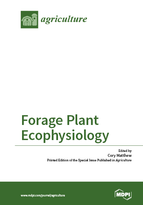Forage Plant Ecophysiology
A special issue of Agriculture (ISSN 2077-0472).
Deadline for manuscript submissions: closed (30 April 2015) | Viewed by 113612
Special Issue Editor
Special Issue Information
Dear Colleagues,
Forage plant ecophysiology has been described, perhaps mischievously, as the selective application of useful information from pure plant physiology research to provide human benefit through improved agricultural output. While intending authors should take notice from this comment that the intention of this project is to create a volume that future researchers will find user friendly and want to consult, the editorial team will also look to produce a volume rich in scientific quality. It is hoped to secure contributions that provide a broad geographic representation and a snapshot of present knowledge and research on a range of forage species in use around the world.
This Special Issue would welcome contributions of both reviews and original research. We hope that contributions will be secured from Europe, North and South America, the Indian sub-continent and Asia. Ideally the contributions will cover major forages in use around the world including C3 grasses, C4 grasses, lucerne/alfalfa, cereal or pulse crops used for forage, and specialist forages such as chicory and plantain.
Dr. Cory Matthew
Guest Editor
Manuscript Submission Information
Manuscripts should be submitted online at www.mdpi.com by registering and logging in to this website. Once you are registered, click here to go to the submission form. Manuscripts can be submitted until the deadline. All submissions that pass pre-check are peer-reviewed. Accepted papers will be published continuously in the journal (as soon as accepted) and will be listed together on the special issue website. Research articles, review articles as well as short communications are invited. For planned papers, a title and short abstract (about 100 words) can be sent to the Editorial Office for announcement on this website.
Submitted manuscripts should not have been published previously, nor be under consideration for publication elsewhere (except conference proceedings papers). All manuscripts are thoroughly refereed through a single-blind peer-review process. A guide for authors and other relevant information for submission of manuscripts is available on the Instructions for Authors page. Agriculture is an international peer-reviewed open access monthly journal published by MDPI.
Please visit the Instructions for Authors page before submitting a manuscript. The Article Processing Charge (APC) for publication in this open access journal is 2600 CHF (Swiss Francs). Submitted papers should be well formatted and use good English. Authors may use MDPI's English editing service prior to publication or during author revisions.
Keywords
- Defoliation (grazing, cutting)
- Herbage accumulation
- Animal feeding value
- Plant secondary metabolites
- Photosynthesis,
- Leaf area index (LAI)
- Roots (root mass, root:shoot ratio, root depth)
- Nutrition (N, P)
- Abiotic stress,
- Water deficit,
- Waterlogging,
- Salt tolerance
- Insect resistance,
- Fungal endophyte,(Neotyphodium / Epichloë)
- C3 grasses
- C4 grasses
- Alfalfa / Lucerne
- Plantain (Plantago lanceolata L)
- Chicory (Cichorium intybus L)






